Silent antagonist - Study guides, Class notes & Summaries
Looking for the best study guides, study notes and summaries about Silent antagonist? On this page you'll find 211 study documents about Silent antagonist.
All 211 results
Sort by
 Popular
Popular
-
NR 546 Midterm Exam 2023/2024 Questions AND Answers Update A+
- Exam (elaborations) • 49 pages • 2023
-
- $16.49
- 2x sold
- + learn more
NR 546 Midterm Exam 2023/2024 Questions AND Answers Update A+ What should the PMHNP consider when prescribing chemical restraints? - Answer-- allergy status -prior med hx for adverse drug reactions r/t the meds ordered in the chemical restraint -state regulations regarding chemical restrains must be reviewed Are the PMHNP and other staff liable if the client has an allergic reaction or adverse side effects to the drugs used for chemical restraint? - Answer-No. The client has been court-...
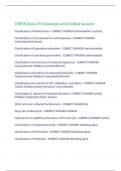 Popular
Popular
-
CPHON Exam 195 Questions with Verified Answers,100% CORRECT
- Exam (elaborations) • 17 pages • 2024 Popular
-
- $12.99
- 1x sold
- + learn more
CPHON Exam 195 Questions with Verified Answers Classification of Methotrexate - CORRECT ANSWER antimetabolite (s-phase) Classification of mercaptopurine and thioguinine - CORRECT ANSWER antimetabolite(s-phase) Classification of fludarabine/nelarabine - CORRECT ANSWER anti-metabolite Classification of cytarabine/gemcitabine - CORRECT ANSWER antimetabolite Classification and sub-class of ironotecan/topotecan - CORRECT ANSWER Topoisomerase inhibitors (campotothecins) Classificatio...
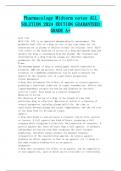
-
Pharmacology Midterm notes ALL SOLUTION 2024 EDITION GUARANTEED GRADE A+
- Class notes • 38 pages • 2024
-
- $22.49
- + learn more
half life Half-life (t½) is an important pharmacokinetic measurement. The metabolic half-life of a drug in vivo is the time taken for its concentration in plasma to decline to half its original level. Half-life refers to the duration of action of a drug and depends upon how quickly the drug is eliminated from the plasma. The clearance and distribution of a drug from the plasma are therefore important parameters for the determination of its half-life. B max The maximum amount of drug or radio...
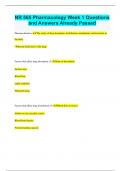
-
NR 565 Pharmacology Week 1 Questions and Answers Already Passed
- Exam (elaborations) • 23 pages • 2024
- Available in package deal
-
- $9.99
- + learn more
NR 565 Pharmacology Week 1 Questions and Answers Already Passed Pharmacokinetics The study of drug absorption, distribution, metabolism, and excretion in the body "What the body does to the drug" Factors that affect drug absorption (5) Rate of dissolution Surface area Blood flow Lipid solubility PH partitioning Factors that affect drug distribution (4) Blood flow to tissues Ability to exit vascular system Blood-brain barrier Protein-binding capacity Pharmacodynamics...

-
NR565 Midterm Study Guide with Complete Solutions
- Exam (elaborations) • 17 pages • 2024
- Available in package deal
-
- $9.99
- + learn more
NR565 Midterm Study Guide with Complete Solutions APRN prescribing role Prescriptive authority for nurse practitioners also regulates prescribing rights beyond medications and controlled substances. These rights include therapeutic devices and services and are outlined in state practice laws and regulations and include Durable Medical Equipment (DME) such as wheelchairs, power scooters, hospital beds, portable oxygen equipment, handicap placards, etc. and medical services such as Physi...
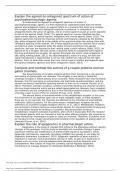
-
Walden University NURS 6630 wek 2
- Exam (elaborations) • 6 pages • 2023
-
- $11.49
- + learn more
Explain the agonist-to-antagonist spectrum of action of psychopharmacologic agents. To understand the agonist-to-antagonist spectrum of action of psychopharmacologic agents, it is first important to understand what does the terms agonist and antagonist means. An agonist refers to a chemical that binds to a receptor, the receptor activates and a biological response is produced. In comparison, an antagonist blocks the action of agonist, and an inverse agonist causes an action opposite to t...
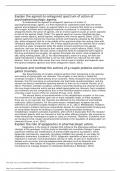
-
Walden University NURS 6630 week 2
- Exam (elaborations) • 6 pages • 2023
-
- $10.49
- + learn more
Explain the agonist-to-antagonist spectrum of action of psychopharmacologic agents. To understand the agonist-to-antagonist spectrum of action of psychopharmacologic agents, it is first important to understand what does the terms agonist and antagonist means. An agonist refers to a chemical that binds to a receptor, the receptor activates and a biological response is produced. In comparison, an antagonist blocks the action of agonist, and an inverse agonist causes an action opposite to t...
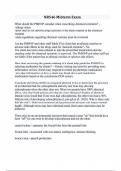
-
NR546 Midterm Exam
- Exam (elaborations) • 56 pages • 2024
-
- $13.00
- + learn more
What should the PMHNP consider when prescribing chemical restraints? – -allergy status -prior med hx for adverse drug reactions r/t the meds ordered in the chemical restraint -state regulations regarding chemical restrains must be reviewed Are the PMHNP and other staff liable if the client has an allergic reaction or adverse side effects to the drugs used for chemical restraint? - No. The client has been court-ordered to take the prescribed medications and the standing order for chemic...
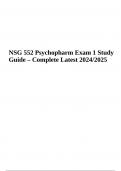
-
NSG 552 Psychopharm Exam 1 Study Guide – Complete Latest 2024/2025
- Exam (elaborations) • 24 pages • 2024
-
Available in package deal
-
- $10.49
- + learn more
Dopamine belongs to the family of catecholamines. It is a neurotransmitter. • Hormones, Epinephrine and Norepinephrine (other catecholamines) are derived from Dopamine • Dopamine plays a significant role in learning, goal-directed behavior, regulation of hormones, motor control. DOPAMINE SYNTHESIS Phenylalanine (amino acid from diet) -> phenyalanine hydroxylase -> Tyrosine -> Tyrosine hydroxylase -> DOPA -> Dopa decarboxylase -> Dopamine KEY POINT: Dopamine is synthe...
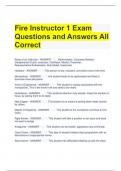
-
Fire Instructor 1 Exam Questions and Answers All Correct
- Exam (elaborations) • 5 pages • 2023
-
Available in package deal
-
- $10.99
- + learn more
Fire Instructor 1 Exam Questions and Answers All Correct Roles of an Instructor - ANSWER Administrator, Counselor/Adviser, Disciplinarian/Coach, evaluator, Facilitator, Mentor, Presenter, Representative/Ambassador, Role Model, Supervisor Hesitator - ANSWER This person is shy, reluctant, and silent most of the time Monopolizer - ANSWER this student tends to be opinionated and likes to dominate class discussion Voice of Experience - ANSWER This ...

$6.50 for your textbook summary multiplied by 100 fellow students... Do the math: that's a lot of money! Don't be a thief of your own wallet and start uploading yours now. Discover all about earning on Stuvia


